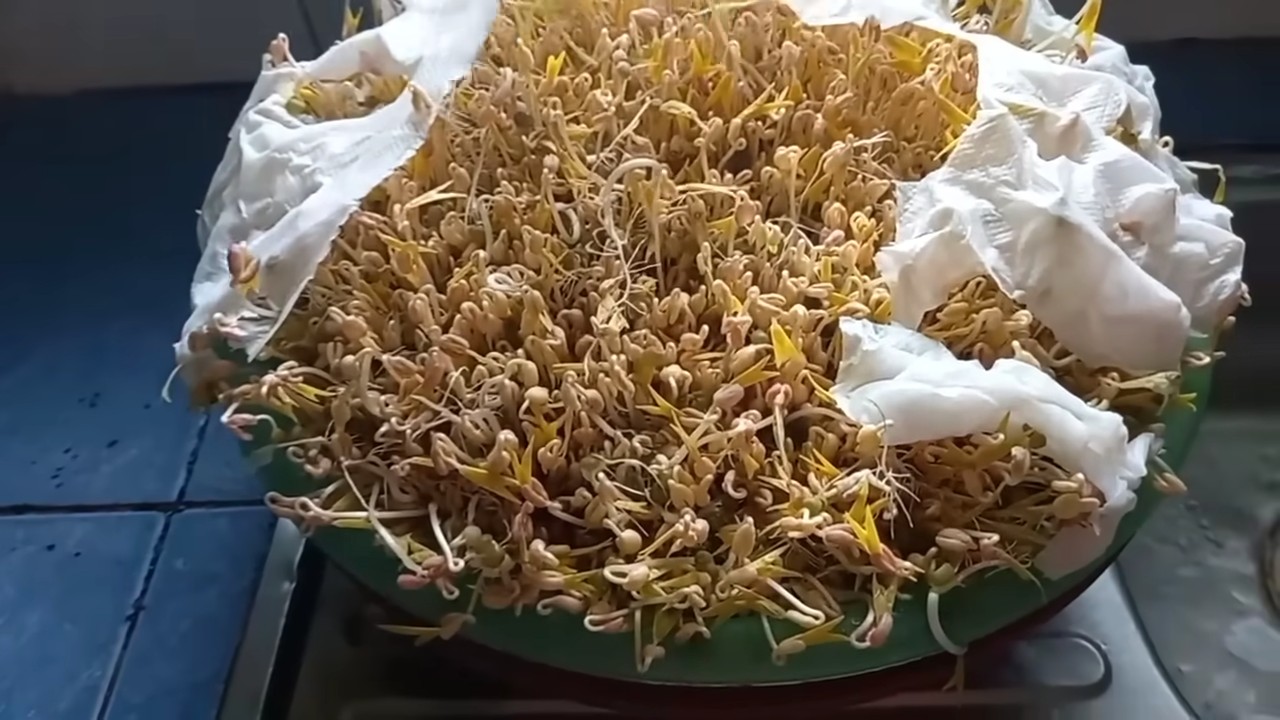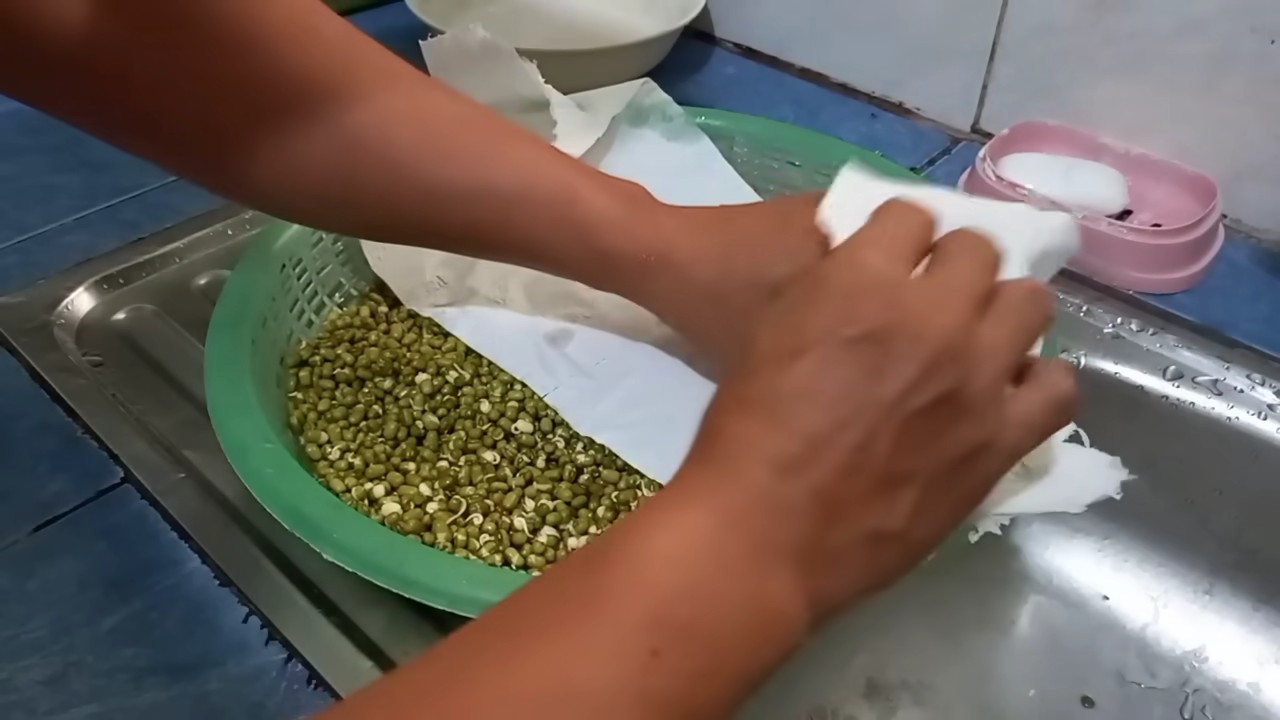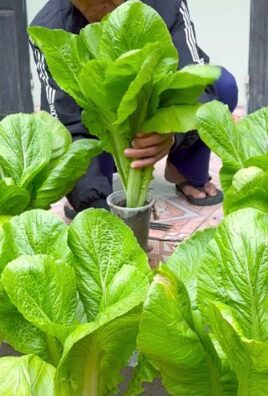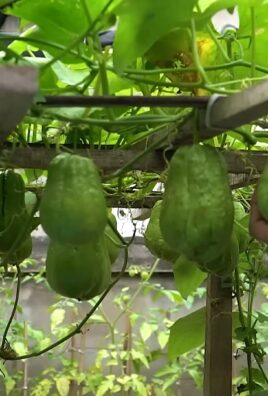Grow Mung Bean Sprouts at home? Absolutely! Forget those pricey, pre-packaged sprouts from the grocery store. I’m going to show you how incredibly easy and rewarding it is to cultivate your own crunchy, nutritious mung bean sprouts right in your kitchen.
Sprouting, in general, isn’t a new fad. It’s a practice with roots stretching back centuries, particularly in Asian cultures where sprouts have long been valued for their nutritional density and digestive benefits. Think of it as a miniature, edible garden bursting with life!
But why should you bother learning to grow mung bean sprouts yourself? Well, for starters, it’s a fantastic way to add a fresh, vibrant element to your meals, especially during the colder months when garden-fresh produce is scarce. Plus, it’s a budget-friendly alternative to buying them. More importantly, you control the entire process, ensuring they’re grown in a clean and safe environment, free from any unwanted additives. Imagine the satisfaction of sprinkling your homemade sprouts on salads, stir-fries, or sandwiches, knowing exactly where they came from and how they were grown. Let’s get sprouting!

Grow Your Own Crunchy Mung Bean Sprouts at Home!
Hey there, fellow food enthusiasts! Are you ready to embark on a super easy and rewarding DIY project? I’m going to show you how to grow your own delicious and nutritious mung bean sprouts right in your kitchen. Forget buying them at the store – this is fresher, cheaper, and way more satisfying. Plus, it’s a fantastic way to add a healthy crunch to your salads, stir-fries, and sandwiches. Let’s get sprouting!
What You’ll Need
Before we dive in, let’s gather our supplies. The beauty of this project is that you probably already have most of these items lying around.
* Mung Beans: Obviously! You can find these at most grocery stores, Asian markets, or online. Look for whole, unbroken beans for the best sprouting results. About 1/2 cup of dry beans will yield a good amount of sprouts.
* A Wide-Mouth Jar: A quart-sized mason jar works perfectly. Make sure it’s clean!
* Sprouting Lid or Cheesecloth: You’ll need something to cover the jar and allow for drainage. A sprouting lid is ideal, but cheesecloth secured with a rubber band works just as well.
* Water: Filtered water is best, but tap water is usually fine too.
* A Dark Place: A cabinet, cupboard, or even a covered box will do the trick. Darkness is key for optimal sprout growth.
* A Bowl or Tray: To prop the jar at an angle for drainage.
Step-by-Step Sprouting Guide
Alright, let’s get down to business! Here’s how to grow your own mung bean sprouts, step by step.
1. Rinse the Beans: Pour your 1/2 cup of mung beans into the jar. Add plenty of cool water and give them a good swirl. This will remove any dust or debris. Drain the water completely.
2. Soak the Beans: Add fresh, cool water to the jar, ensuring the beans are fully submerged. They’ll expand quite a bit during soaking, so give them plenty of room. Cover the jar with your sprouting lid or cheesecloth and secure it.
3. Soaking Time: Let the beans soak for 8-12 hours, or even overnight. This is crucial for activating the sprouting process. I usually soak mine overnight so I can continue the process in the morning.
4. Drain and Rinse (Day 1): After soaking, drain all the water from the jar. Rinse the beans thoroughly with cool water, again making sure to drain completely. This is important to prevent mold growth.
5. Darkness is Your Friend: Place the jar upside down in your bowl or tray at an angle. This allows any excess water to drain out. Now, place the jar in your dark location. Remember, darkness encourages the sprouts to grow long and white.
6. Rinse and Repeat (Days 2-5): This is the most important part! Rinse and drain the sprouts 2-3 times a day. This keeps them moist and prevents them from drying out or getting moldy. Always use cool water and ensure thorough drainage. I usually do it in the morning, afternoon, and before bed.
7. Observe the Magic: Over the next few days, you’ll see tiny sprouts emerging from the beans. It’s so exciting to watch them grow! Continue rinsing and draining regularly.
8. Harvest Time (Day 5-7): Your mung bean sprouts are ready to harvest when they’re about 1-2 inches long. The exact timing depends on your preference and the temperature of your kitchen. I like mine when they’re nice and crunchy.
9. Final Rinse and De-Hulling (Optional): Before eating, give your sprouts a final rinse. You can also remove the hulls (the outer skins of the beans) if you prefer. This is a bit tedious, but it makes the sprouts look nicer. To do this, fill a bowl with water, add the sprouts, and gently agitate them. The hulls will float to the top, and you can skim them off.
10. Storage: Store your freshly grown mung bean sprouts in the refrigerator in an airtight container. They’ll keep for about a week. I usually line the container with a paper towel to absorb any excess moisture.
Troubleshooting Tips
Even with the best instructions, sometimes things can go a little sideways. Here are a few common issues and how to fix them:
* Mold Growth: This is usually caused by insufficient rinsing or drainage. If you see mold, unfortunately, you’ll have to discard the batch and start over. Make sure you’re rinsing thoroughly and draining completely 2-3 times a day. Also, ensure good air circulation around the jar.
* Slow Growth: If your sprouts are growing slowly, it could be due to temperature. Mung beans prefer a slightly warmer environment (around 70-75°F). If your kitchen is too cold, try placing the jar in a slightly warmer spot.
* Bitter Taste: A bitter taste can indicate that the sprouts are overripe. Harvest them a little earlier next time.
* Rotting Smell: A rotting smell is a sign of bacterial growth, usually due to poor hygiene. Make sure your jar and sprouting equipment are clean before starting.
Creative Ways to Use Your Sprouts
Now that you have a bounty of fresh mung bean sprouts, it’s time to get creative in the kitchen! Here are some of my favorite ways to use them:
* Salads: Add a crunchy texture and fresh flavor to your salads. They pair well with Asian-inspired dressings.
* Stir-Fries: Toss them into your stir-fries for a healthy and satisfying crunch. Add them towards the end of cooking to prevent them from becoming soggy.
* Sandwiches and Wraps: Add a layer of sprouts to your sandwiches and wraps for extra flavor and nutrition.
* Spring Rolls: They’re a classic ingredient in fresh spring rolls.
* Soups: Sprinkle them on top of soups for added texture and flavor.
* Juices and Smoothies: For a nutritional boost, add a handful of sprouts to your juices and smoothies.
Why Grow Your Own?
You might be wondering, “Why bother growing my own sprouts when I can just buy them at the store?” Well, here’s why I think it’s worth the effort:
* Freshness: Homegrown sprouts are incredibly fresh and flavorful. You can’t beat the taste of something you’ve grown yourself.
* Cost-Effective: A bag of mung beans is relatively inexpensive, and it will yield a lot of sprouts. You’ll save money compared to buying them at the store.
* Control: You have complete control over the growing process, ensuring that your sprouts are free from pesticides and other harmful chemicals.
* Fun and Educational: It’s a fun and educational project for kids and adults alike. It’s a great way to learn about plant growth and where your food comes from.
* Nutritional Value: Mung bean sprouts are packed with vitamins, minerals, and enzymes. They’re a healthy addition to any diet.
Tips for Success
Here are a few extra tips to help you achieve sprouting success:
* Use High-Quality Beans: Start with fresh, high-quality mung beans for the best results.
* Maintain Hygiene: Keep your jar and sprouting equipment clean to prevent mold and bacterial growth.
* Rinse Regularly: Don’t skip the rinsing! It’s crucial for keeping the sprouts moist and preventing mold.
* Ensure Drainage: Proper drainage is essential to prevent the sprouts from becoming waterlogged.
* Experiment: Don’t be afraid to experiment with different soaking times, rinsing frequencies, and harvesting times to find what works best for you.
A Little More Detail on Rinsing and Draining
I can’t stress enough how important rinsing and draining are. Think of it like this: you’re providing the sprouts with the moisture they need to grow, but you’re also preventing them from sitting in stagnant water, which can lead to mold and rot.
When you rinse, use cool, clean water. Swirl the sprouts around gently to dislodge any debris. Then, drain the water *completely*. This is where the angled jar and sprouting lid (or cheesecloth) come in handy. Make sure no water is pooling at the bottom of the jar.
If you live in a humid environment, you might need to rinse more frequently. If your kitchen is very dry, you might need to rinse a little less often. The key is to observe your sprouts and adjust accordingly. They should be moist but not soggy.
De-Hulling: To Do or Not To Do?
Removing the hulls (the outer skins) is optional, but it can improve the appearance and texture of your sprouts. Some people find the hulls a bit tough or bitter.
If

Conclusion
So, there you have it! Growing your own mung bean sprouts at home is not only incredibly easy and cost-effective, but it also guarantees you’re consuming the freshest, most nutritious sprouts possible. Forget those limp, sad-looking sprouts from the grocery store – with this simple DIY trick, you can have a constant supply of crisp, flavorful sprouts ready to add a vibrant crunch to your salads, stir-fries, sandwiches, and more.
Why is this a must-try? Because it empowers you to take control of your food source, reduces your reliance on pre-packaged produce, and introduces you to the rewarding experience of nurturing something from seed to table. Plus, the taste difference is undeniable. Homegrown mung bean sprouts boast a superior sweetness and a satisfying snap that you just can’t find in commercially produced varieties.
Looking for variations? Experiment with different types of beans! While this guide focuses on mung beans, you can adapt the same principles to grow other sprouts like alfalfa, radish, or even lentil sprouts. Just be sure to research the specific soaking and sprouting times for each type of bean. You can also play around with the sprouting environment. Some people prefer using a jar with a sprouting lid, while others find success with a colander lined with cheesecloth. The key is to maintain consistent moisture and darkness. Consider adding a small amount of organic fertilizer to the water during the sprouting process to boost nutrient content.
Another fun variation is to experiment with different flavors after the sprouts have grown. A light toss with sesame oil, soy sauce, and a sprinkle of toasted sesame seeds can elevate your sprouts to a whole new level. Or, try adding a pinch of red pepper flakes for a spicy kick. The possibilities are endless!
We wholeheartedly encourage you to try this DIY trick for growing mung bean sprouts. It’s a fun, educational, and delicious project that the whole family can enjoy. Not only will you be rewarded with a bounty of fresh, healthy sprouts, but you’ll also gain a newfound appreciation for the magic of nature.
Don’t be intimidated by the process. It’s far simpler than you might think. Just follow the steps outlined in this guide, and you’ll be well on your way to enjoying your own homegrown sprouts in no time.
Once you’ve given it a try, we’d love to hear about your experience! Share your tips, tricks, and photos in the comments below. Let’s build a community of sprout enthusiasts and inspire others to embrace the joys of homegrown goodness. Happy sprouting!
Frequently Asked Questions (FAQ)
What are the nutritional benefits of mung bean sprouts?
Mung bean sprouts are a nutritional powerhouse, packed with vitamins, minerals, and antioxidants. They are an excellent source of vitamin C, vitamin K, folate, and various B vitamins. They also contain essential minerals like manganese, magnesium, phosphorus, and potassium. Furthermore, mung bean sprouts are a good source of protein and fiber, making them a filling and healthy addition to your diet. The sprouting process itself increases the bioavailability of nutrients, making them easier for your body to absorb. Eating mung bean sprouts can contribute to improved digestion, a stronger immune system, and overall well-being.
How long does it take to grow mung bean sprouts?
The entire process of growing mung bean sprouts typically takes between 3 to 5 days. The initial soaking period is usually around 8 to 12 hours. After soaking, the sprouts need to be rinsed and drained regularly (2-3 times a day) and kept in a dark, humid environment. You’ll start to see sprouts emerging within the first 24 hours after soaking, and they’ll continue to grow rapidly over the next few days. The exact time will depend on the temperature and humidity of your environment, so keep an eye on them and adjust the rinsing frequency as needed.
What kind of container should I use to grow mung bean sprouts?
You have several options when it comes to choosing a container for growing mung bean sprouts. A wide-mouth mason jar with a sprouting lid is a popular choice because it allows for easy rinsing and drainage. Alternatively, you can use a colander lined with cheesecloth or a clean kitchen towel. The key is to ensure that the container allows for adequate drainage and ventilation to prevent mold growth. Avoid using containers that are too deep or narrow, as this can restrict airflow and lead to uneven sprouting. Make sure the container is clean and sanitized before use to prevent contamination.
How often should I rinse the mung bean sprouts?
Rinsing the mung bean sprouts is crucial for their healthy growth and to prevent the formation of mold or bacteria. You should rinse them at least 2-3 times per day with fresh, cool water. The rinsing process helps to remove any accumulated metabolic byproducts and keeps the sprouts hydrated. After rinsing, ensure that you drain the water thoroughly to prevent them from sitting in excess moisture. If you live in a particularly warm or humid environment, you may need to rinse them more frequently.
How do I know when the mung bean sprouts are ready to eat?
Mung bean sprouts are ready to eat when they have reached your desired length and thickness. Typically, they are harvested when they are about 2-3 inches long. The sprouts should be crisp and firm, with a slightly sweet taste. Avoid letting them grow too long, as they can become bitter and less palatable. You can taste a small sprout to check for flavor and texture before harvesting the entire batch.
How do I store mung bean sprouts?
Once your mung bean sprouts are ready, it’s important to store them properly to maintain their freshness and prevent spoilage. Rinse them thoroughly one last time and drain them well. Then, place them in a clean, airtight container lined with a paper towel to absorb excess moisture. Store the container in the refrigerator. Mung bean sprouts are best consumed within 3-5 days of harvesting. Check them regularly for any signs of spoilage, such as a slimy texture or a foul odor.
Can I grow mung bean sprouts without soil?
Yes, absolutely! This method focuses on growing mung bean sprouts without soil, using only water and a suitable container. The sprouts obtain all the necessary nutrients from the beans themselves during the germination process. This makes it a clean and simple method, perfect for growing sprouts indoors without the mess of soil.
What if my mung bean sprouts start to smell bad?
A bad smell is a sign that your mung bean sprouts may have been contaminated with bacteria or mold. This is usually due to insufficient rinsing or poor drainage. If you notice a foul odor, it’s best to discard the entire batch to avoid the risk of food poisoning. To prevent this from happening, ensure that you rinse the sprouts thoroughly and frequently, and that your container allows for adequate drainage and ventilation.
Can I eat the green husks of the mung beans?
Yes, the green husks of the mung beans are perfectly safe to eat. They are a natural part of the bean and do not contain any harmful substances. Some people prefer to remove them for aesthetic reasons, but it’s not necessary. If you find them bothersome, you can try to gently rub the sprouts between your hands under running water to dislodge some of the husks.
Are there any risks associated with eating raw mung bean sprouts?
While mung bean sprouts are generally safe to eat raw, there is a small risk of foodborne illness, particularly if the sprouts are not grown or stored properly. Bacteria like Salmonella and E. coli can sometimes contaminate sprouts. To minimize this risk, it’s crucial to use clean water and sanitized containers, rinse the sprouts thoroughly, and store them properly in the refrigerator. If you are pregnant, elderly, or have a compromised immune system, you may want to consider lightly cooking the sprouts before eating them to further reduce the risk of illness.




Leave a Comment